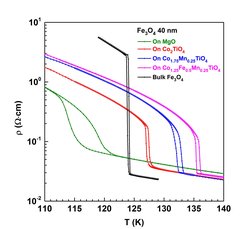Fe3O4 thin films: controlling and manipulating an elusive quantum material
Fe3O4 (magnetite) is one of the most studied quantum materials. Numerous studies have been devoted to describe and to understand its enigmatic Verwey transition, also the first example of a metal-insulator transition in oxides. Yet, the underlying mechanism remains elusive. Nevertheless, the theoretically expected half-metallic behavior generates high expectations that magnetite in the thin film form can be used in spintronic devices such as spin valves, magnetic tunnel junctions, and so on. However, up to now, in the twenty years of intensive research on Fe3O4 thin films, the Verwey transition is in thin films extremely broad and occurs at substantially lower temperatures as compared to that in high quality bulk single crystals. Also here it is not at all clear why.
Recently, scientists at MPI CPfS have succeeded in growing magnetite thin films which not only have the Verwey transition as sharp as in the bulk, but also show transition temperatures that are substantially higher than the bulk. The break through is the realization that the substrate is equally important as the Fe3O4 thin film. We have identified the Co(2-x-y)Mn(x)Fe(y)TiO4 system as the material of choice, and have made special efforts to grow single crystals of this for the fabrication of the substrates.
Using these tailor-made substrates, our record of the Verwey transition temperature so far, which is the world record as well, is 136.5 K, about 12 K higher than that of the bulk single crystal and about 25 K higher than that of epitaxial thin films so far published. The key physics principle behind this success is to obtain thin films with sufficiently large domains and sufficiently small domain-size distribution. This is a principle that can be used also for the study of other thin film materials having first order transitions. Once the domain conditions are fulfilled, one will be able to tune in a controlled manner the transition temperature by exerting proper strain, either tensile or compressive.
XHL, CFC, LHT / CPfS

Electrical transport properties: Resistivity as a function of temperature of 40 nm Fe3O4 thin films grown on MgO (001), Co2TiO4 (001), Co1.75Mn0.25TiO4 (001), and Co1.25Fe0.5Mn0.25TiO4 (001) substrates and of single crystal bulk Fe3O4.
